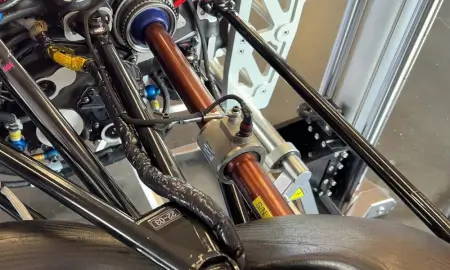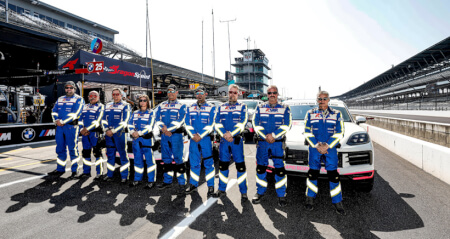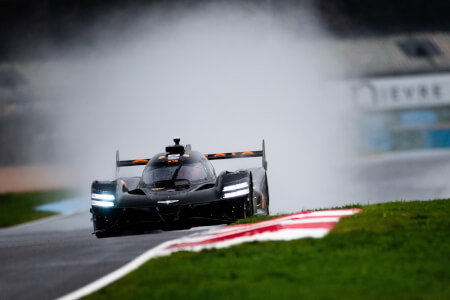November 14th 2024
GT torque sensors getting first rollout at IMSA's Daytona test
This week’s three-day IMSA test at Daytona International Speedway will feature approximately 30 cars in attendance from all four WeatherTech SportsCar Championship classes, and in a new twist, the series will be doing more than trying to gather Balance of Performance data to use for January’s Rolex 24 At Daytona.
The main emphasis for IMSA’s Friday-Sunday outing is the new application of torque sensors on the supercars in its GT Daytona and GT Daytona Pro categories. Implemented by IMSA in 2023 within its hybrid Grand Touring Prototype cars, the series is expanding the deployment of torque sensors beyond GTP to include all GTD models in 2025 as a method of improving BoP information gathering and governing methods for its GT3-based field.
Torque sensors serve as miniature chassis dynamometers attached to the rear axles which feed constant performance information — horsepower, torque, and acceleration curve data are among the key channels — to the series through telemetry, and highlight any related BoP violations that are detected through the sensors.
With such great variance in the layouts of its GT entries from Aston Martin, BMW, Corvette, Ferrari, Ford, Lamborghini, Lexus, McLaren, Mercedes-AMG and Porsche, IMSA’s technical staff will rely on the torque sensors made by Magcanica to better balance the array of front-engine designs with inline turbo six-cylinder motors, front-engine naturally-aspirated and turbo V8s, mid-engine turbo V6s, mid-rear-engine flat sixes, mid-engine naturally-aspirated and turbo V8s, and mid-engine naturally-aspirated V10s from track to track.
With such great variance in the layouts of its GT entries from Aston Martin, BMW, Corvette, Ferrari, Ford, Lamborghini, Lexus, McLaren, Mercedes-AMG and Porsche, IMSA’s technical staff will rely on the torque sensors made by Magcanica to better balance the array of front-engine designs with inline turbo six-cylinder motors, front-engine naturally-aspirated and turbo V8s, mid-engine turbo V6s, mid-rear-engine flat sixes, mid-engine naturally-aspirated and turbo V8s, and mid-engine naturally-aspirated V10s from track to track.
Through its BoP modeling for each car as a tool to create parity, manufacturers are given performance turning parameters to play within, and with torque sensors, the series is able to track each car’s engine output and acceleration figures from corner to corner on every lap. The sensors also act as electronic referees, flagging any breaches of the BoP limits put in place by IMSA as they occur.
The decision to carry over the same torque sensors from GTP to its GTD and GTD Pro cars also means the series brings exceptional familiarity to the use of the units in competition, but that’s not the case for most GT teams and manufacturers in the WeatherTech Championship paddock, which is why the series is using the November test at Daytona as an opportunity for its GT entrants to learn about the sensors during the numerous test sessions.
“One of the primary things we were trying to accomplish was an ability to get the GTD and GTD Pro cars on the racetrack, to provide the manufacturers, the teams and IMSA, an opportunity to see this new technology integrated into their cars,” Matt Kurdock, IMSA’s director of engineering, told RACER. “It’s a fundamentally different way that the powertrain will be regulated, and we felt that it’s a significant enough of a technical regulation change that it would be beneficial to provide the opportunity get the get the cars on track with adequate time to address any issues prior to the Roar Before The 24 [test in January].
“Not only will some of these systems be used for the first time by some of the teams, but we also need to make sure that all of the monitoring and regulating electronics are working in conjunction with the with the updates the manufacturers have done to their cars. We like to call it a ‘systems integration test,’ and we will have the opportunity to then work throughout the event to address any issues that pop up. But also if there’s anything that IMSA or the manufacturers need to address before the roar, there’s some adequate time to look into it.”
With the adoption of torque sensors across the two GTD categories, IMSA will drastically alter its usual engine BoP adjustment techniques for aligning vehicle performance along with bringing in a new two-tier BoP table.
With the adoption of torque sensors across the two GTD categories, IMSA will drastically alter its usual engine BoP adjustment techniques for aligning vehicle performance along with bringing in a new two-tier BoP table.
“When we did this before, we would regulate power through air restrictors and boost limits as a function of engine speed, and we would set the maximum fuel capacity,” Kurdock said. “Those three things go by the wayside now, and we’re going to regulate power to a maximum power curve, defined as not only a function of engine speed, but we are going to implement something called two-stage power.”
Based on the shape of the car — some being low-slung while others are tall — or the different manners their respective engine architectures make power, the range of GT machinery has inherent strengths and weaknesses at each IMSA circuit.
At Daytona, for example, a waist-high Ferrari 296 would be more likely to smoothly cut through the air and achieve a higher top speed on the long straights than a chest-high sedan like BMW’s M4, and with the new two-stage BoP power approach, settings in the second stage can help address any advantages or shortcomings as cars near maximum velocity.
The first stage, where naturally-aspirated motors offer instantaneous acceleration while turbocharged engines need an extra moment or two to spool up and deliver big power and torque, is where IMSA will address any innate disparities.
“We’ll have one power curve up to a certain vehicle speed, and then another power curve potentially on some cars after a certain vehicle speed,” Kurdock continued. “And the whole idea there is to better regulate how cars achieve their lap time, and to give us more tools in the toolbox on getting the getting the parity on acceleration and top speed and things like that. So we’re also going to implement that in GTP. And if you look at the BoP tables we published, they’ve been redefined along those lines on having two-stage power. That’s another thing we’ll be trying.”
The two-stage BoP approach has been employed by IMSA’s European counterpart.
“It’s not the first time it’s been used; the World Endurance Championship has used that,” Kurdock said. “And we think, particularly as we go into a very power and drag sensitive race track like Daytona, it’s just going to give us more capability on what we can do to balance the cars.”
Once IMSA’s GT field has a full understanding of how the torque sensors function, Kurdock says the emphasis will shift to the governance side offered by the technology once the new season gets under way.
“The torque sensors are less of a monitoring tools and more of regulating tools,” he confirmed. “So if a power limit were to be exceeded, there’s tools running in IMSA’s logger that that will quantify that and notify us real-time over telemetry and there could be associated penalties with that.”
Another new area of oversight will be enacted with the GT torque sensors – one that’s borrowed from the hybrid GTP cars to dictate the length of time between pit stops.
“For us, it’s a tool that’s going to regulate the power output and also regulate the stint length, because we’re employing the maximum-stint energy like we use in GTP to control how teams are able to hit these stint-length targets across all these different [GT3] platforms,” Kurdock said. “So just like it has proven in GTP, it still comes down to what the driver does on how they’re able to use traditional fuel saving strategies. Those also work on energy savings.
“So we expected to see the same benefits of that regulation as they apply to GTD, where we had a very wide array of powertrain and engine combinations that for years, we can see that not every not every engine has the capability to save fuel the same way, and it wasn’t coming down to just the driver. The car was a factor. So with the maximum-stint energy system, and using the torque sensors to calculate the energy, we feel that it really puts it back in the driver’s hands on extending the stint length and less so the inherent technical advantages of one engine configuration over another.”
More traditional BoP testing will take place for IMSA’s GTP and LMP2 cars, and in another first, a non-LMDh car (all GTP models from Acura, BMW, Cadillac, Lamborghini, and Porsche are built to LMDh regulations) will make its WeatherTech Championship debut with Aston Martin Racing’s Valkyrie, which conforms to the freer LMH rules that Ferrari and other brands have used in the WEC’s Hypercar class.
“We felt it was important to provide them the opportunity to get on the racetrack,” Kurdock said. “It’s an opportunity to also see the new Aston Martin Valkyrie at IMSA event and making sure that our systems integrate well with that car, that our scrutineering processes can be tested on that car as well. And it’s the first time an LMH will be running in GTP. So there’s some differences in the technical regulations and some of the procedures we have to use to make sure the car is running within the regulations.”
For more information: www.racer.com
For more Industry News, please Click Here
For more information: www.racer.com
For more Industry News, please Click Here














